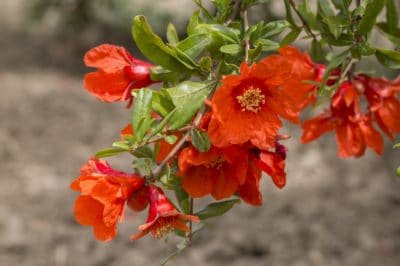About Pomegranates
Once considered an exotic fruit, pomegranates are now readily available in late summer and fall. The bulk of the commercial production comes from India, although California and Arizona also produce pomegranates. Native to arid, warm areas, the tree will grow up to about 30 feet tall and does best in USDA Zones 8 to 10. It is deciduous in most areas.
About Pomegranate Flowers
Unlike many fruit trees, pomegranates produce both male and female flowers on the same tree. The male flowers can pollinate female flowers on the same tree or other trees. Flowers have three to five petals, primarily in shades of orange and red – rarely, pink. Some varieties have highly ruffled edges or may be edged with white. The flowers have a light, sweet fragrance.
Pomegranate Varieties
Even in colder areas, you may be able to grow pomegranates for the fragrant blossoms. Here are some possibilities:
- Punica granatum ‘Nana’ – dwarf variety; orange flowers.
- Punica granatum ‘Wonderful’ – common commercial variety with orange-red flowers.
- Punica granatum ‘Flore Pleno’ – multi-petaled ruffled orange or red flowers.
- Punica protopunica – pink flowers, and tart, small fruit.
Pomegranate Flowering Season
Depending on the variety, flowers may appear on the pomegranate tree at different times, but the flowering season is generally late summer to fall. Most varieties flower in August and September. A few will have bursts of flowers throughout the summer and into the fall. Occasionally, one will display both fruits and flowers at the same time.
Problems with Flowering
Many pomegranates will begin to display scattered flowers at a young age, although they may not fruit for several years afterward. At maturity – usually around four or five years – the tree will flower more heavily. The male and unfertilized female flowers drop off naturally; this is not a problem. Insect infestation, unexpected cold weather and severe lack of water may also cause blossom drop.
Growing Pomegranates
Pomegranates are not difficult to grow. They will accept almost any soil but heavy clay as long as it drains well. Drought-tolerant, they need water about once a week. Go easy on the fertilizer – pomegranates are native to areas with poor soils. An organic mulch around the trees may be all it needs to grow and produce well. Prune to shape and remove dead or broken branches.
